Abstract
Extracted lipopolysaccharides (LPS) from one smooth, one semirough, and five rough mutants of Salmonella typhimurium LT2 or LT7, for which the chemical structure of the polysaccharide chain had been elucidated by using methylation analysis, were characterized with passive hemagglutination inhibition and phage inactivation experiments. Each addition of a sugar residue to a LPS from chemotype Rc was reflected in changed serological reactivity and phage-inhibiting activity of a collection of bacteriophages of the isolated LPS. Thus, certain criteria can be established for a classification of rough mutants of S. typhimurium. The observation that the serological RII specificity corresponds to a completed common core polysaccharide was verified. The serological RI specificity was found in LPS with terminal d-galactose I residues. One of the mutants, SL733, yielded a LPS which cross-reacted with anti-O5 factor serum although the polysaccharide was virtually free from contaminating O-specific material. The O5 reactivity was destroyed by alkaline treatment of SL733 LPS. The smooth- and rough-specific Felix O-l (FO) and the rough-specific 6SR and Br2 phages were shown to have their receptors in the LPS. There was a good correlation between the adsorption rate constant to whole cells and the phage inhibiting activity of isolated LPS suggesting that the LPS exert the major influence on the attachment of these phages to the bacteria. The polysaccharide structures in the LPS necessary for attachment of the 6SR and Br2 phages were defined. It was found that measuring the phage-inhibiting properties of isolated LPS as PhI50 (LPS concentration required to inactivate 50% of the phages under defined conditions) was a more sensitive method for a characterization of the LPS than the serological and chemical assays used.
Full text
PDF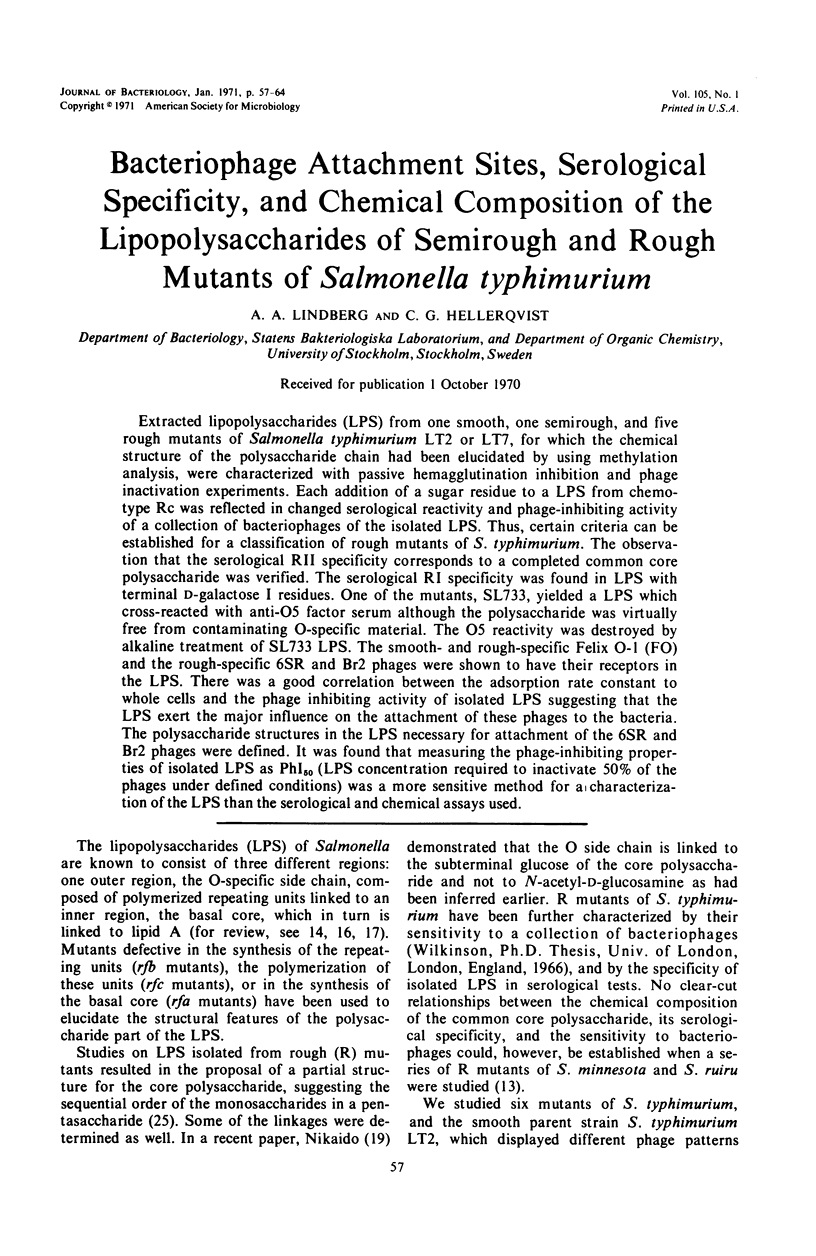
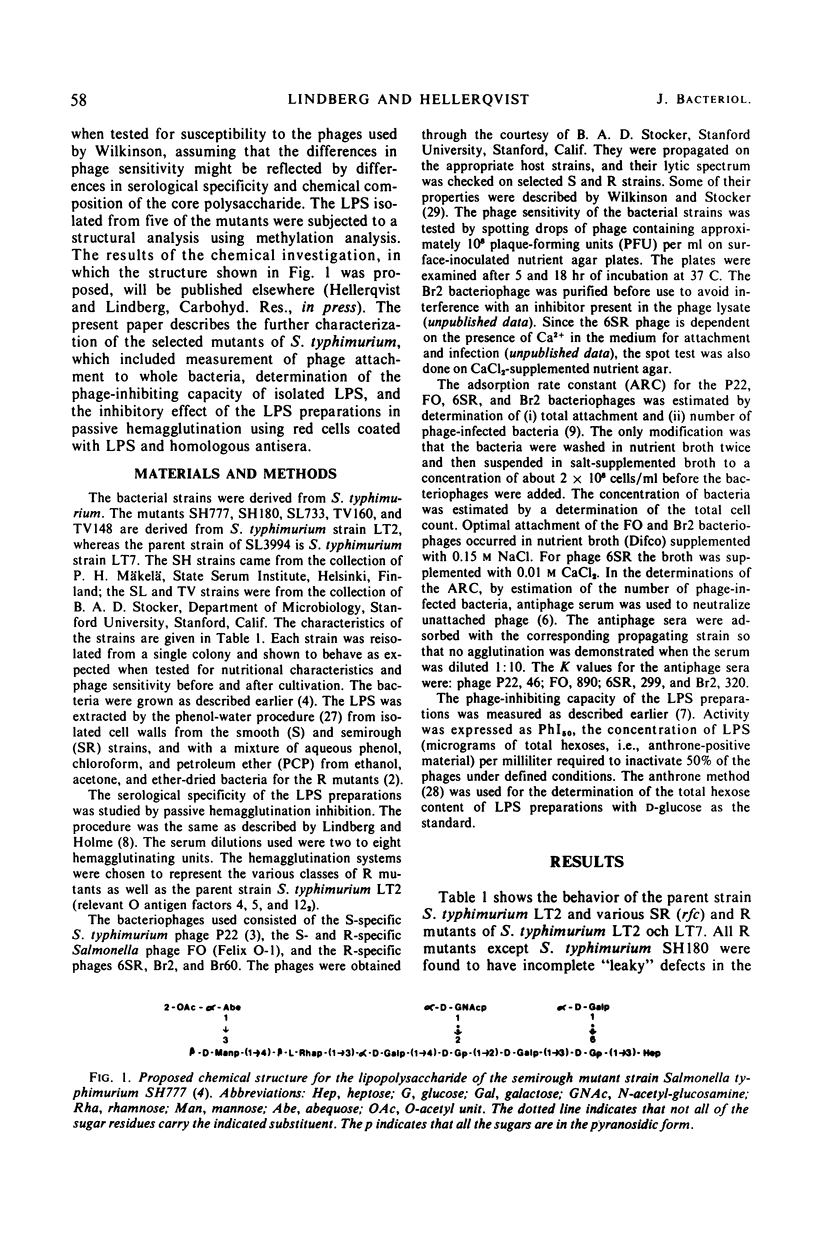
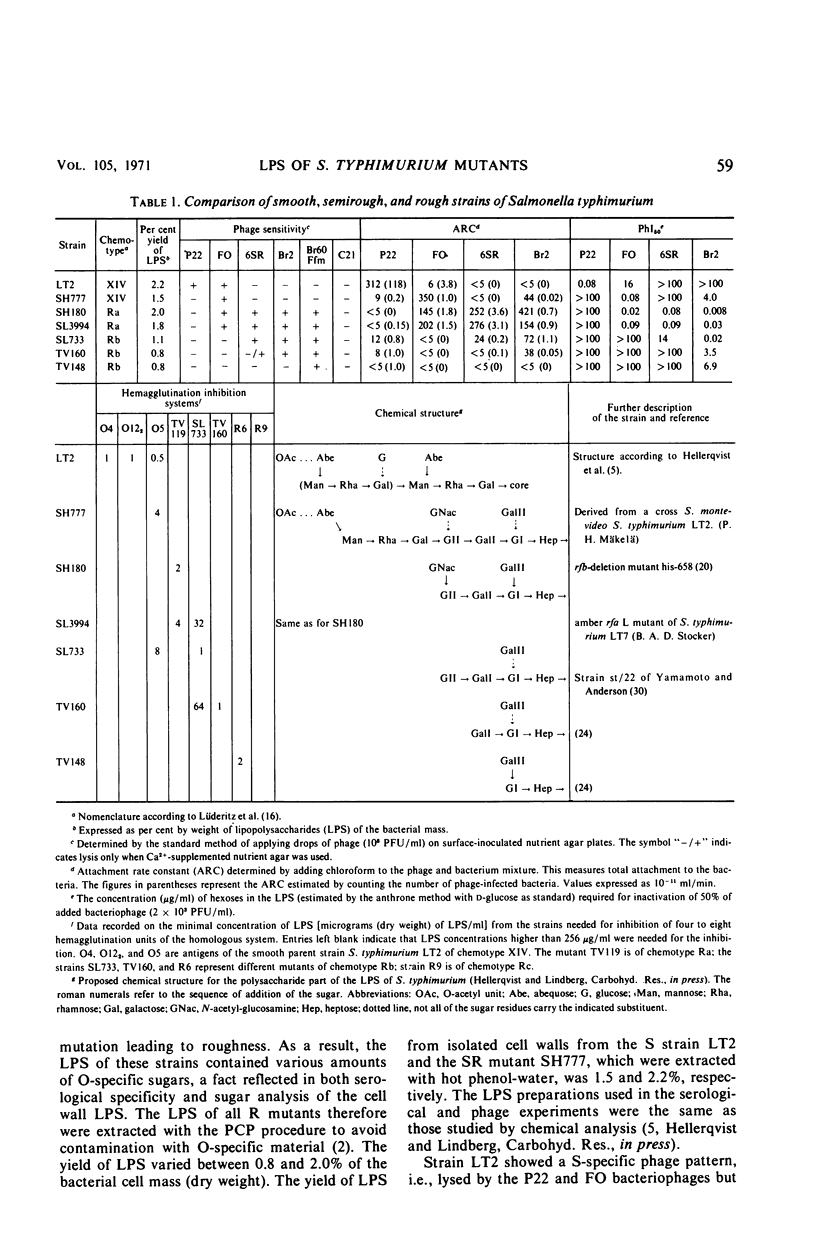
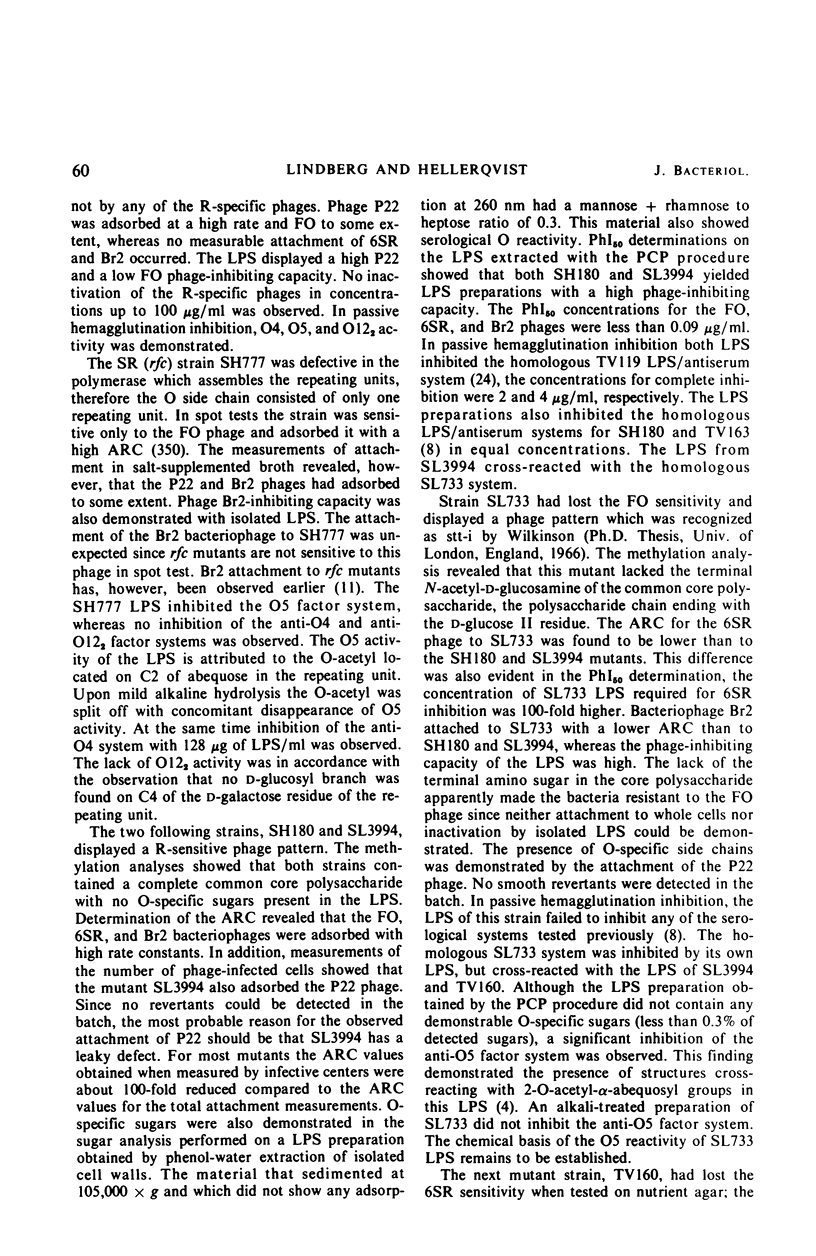
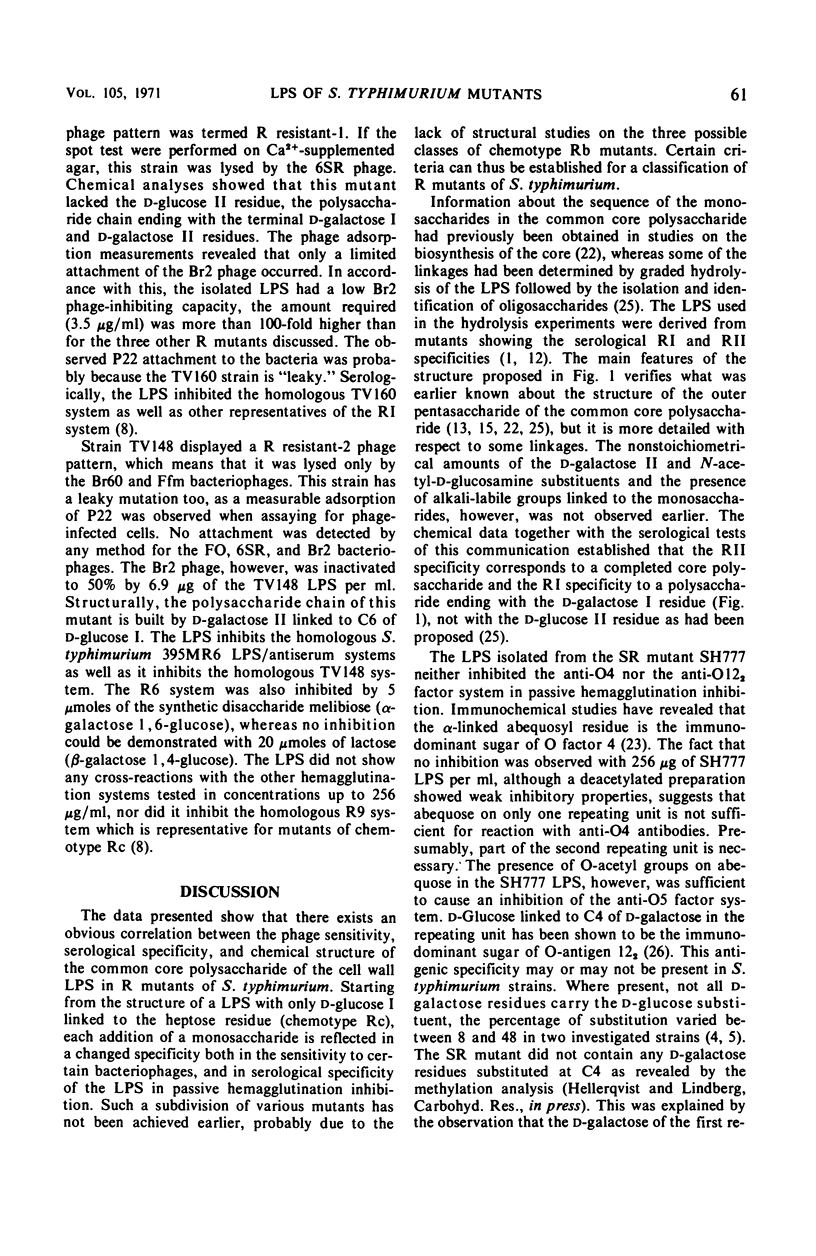
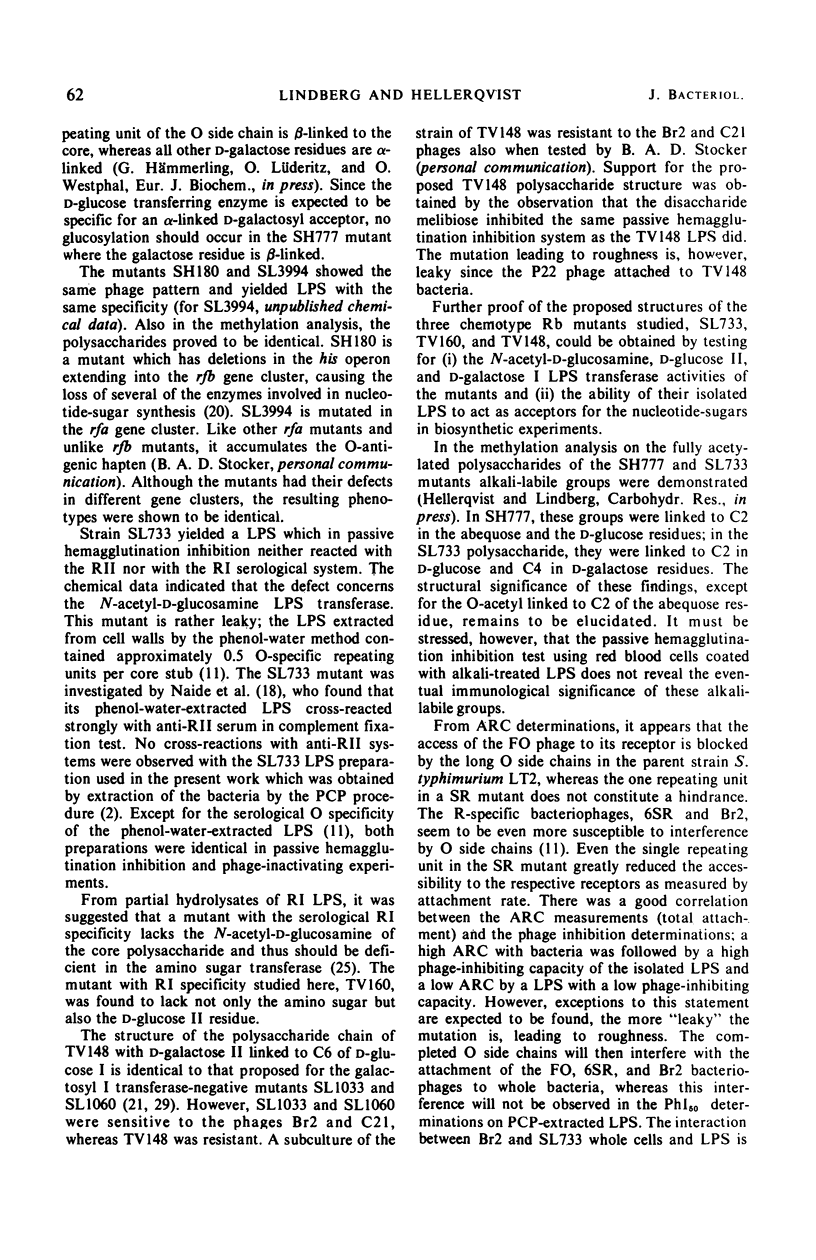
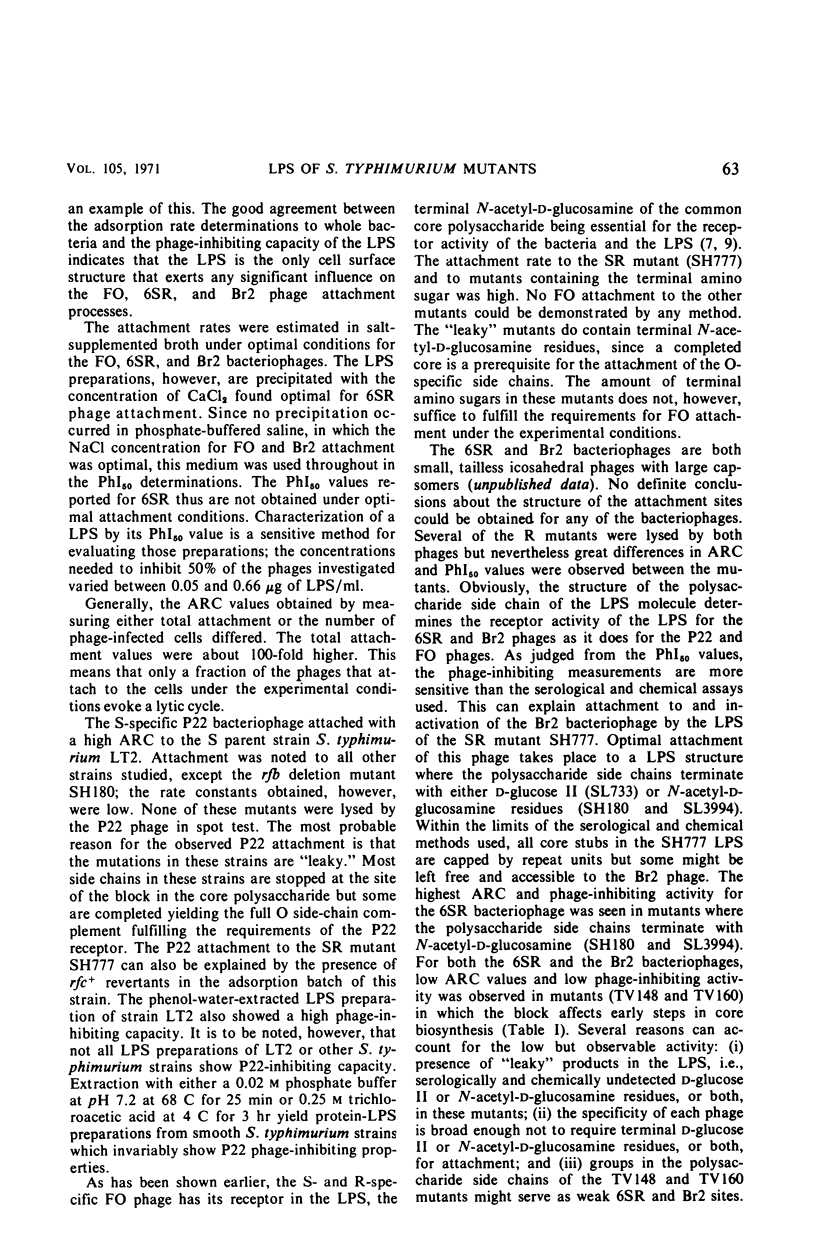
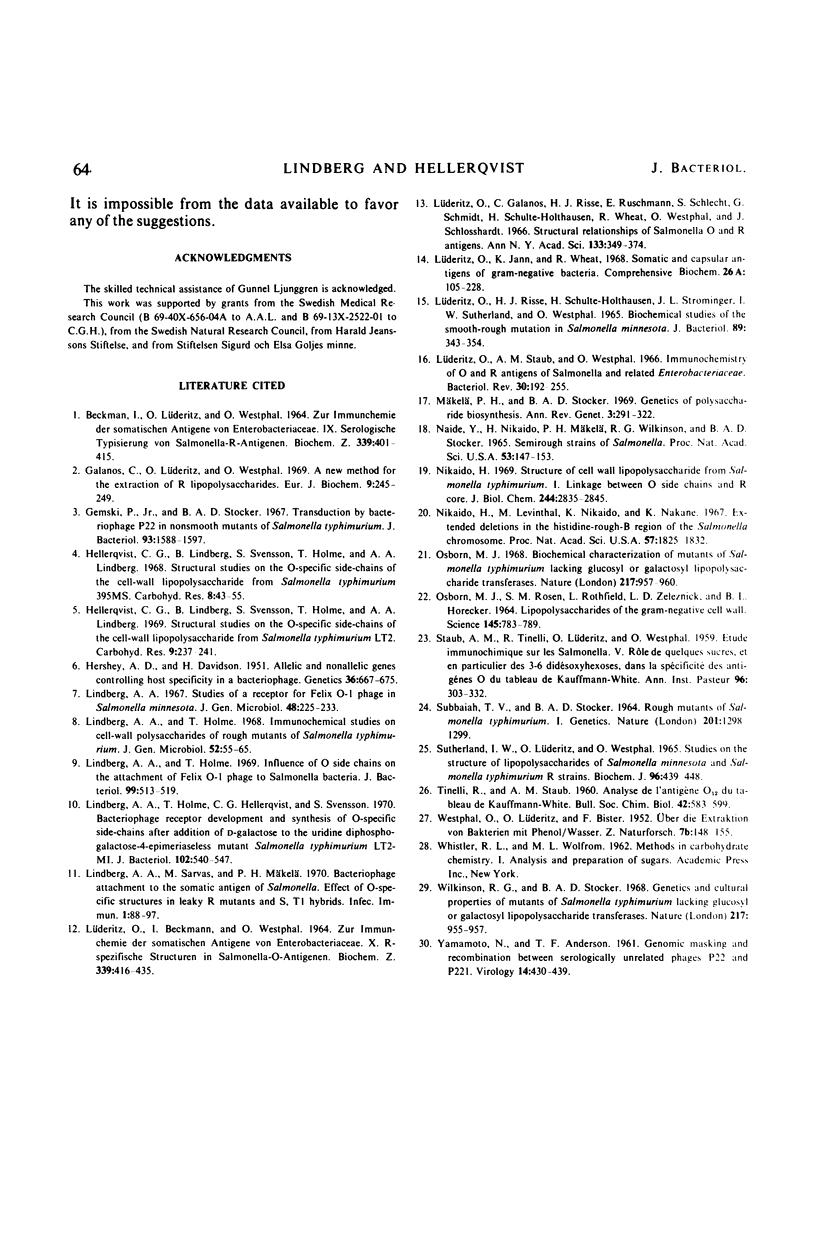
Selected References
These references are in PubMed. This may not be the complete list of references from this article.
- BECKMANN I., LUEDERITZ O., WESTPHAL O. ZUR IMMUNCHEMIE DER SOMATISCHEN ANTIGENE VON ENTEROBACTERIACEAE. IX. SEROLOGISCHE TYPISIERUNG VON SALMONELLA-R-ANTIGENEN. Biochem Z. 1964 May 22;339:401–415. [PubMed] [Google Scholar]
- Galanos C., Lüderitz O., Westphal O. A new method for the extraction of R lipopolysaccharides. Eur J Biochem. 1969 Jun;9(2):245–249. doi: 10.1111/j.1432-1033.1969.tb00601.x. [DOI] [PubMed] [Google Scholar]
- Gemski P., Jr, Stocker B. A. Transduction by bacteriophage P22 in nonsmooth mutants of Salmonella typhimurium. J Bacteriol. 1967 May;93(5):1588–1597. doi: 10.1128/jb.93.5.1588-1597.1967. [DOI] [PMC free article] [PubMed] [Google Scholar]
- Hershey A D, Davidson H. Allelic and Nonallelic Genes Controlling Host Specificity in a Bacteriophage. Genetics. 1951 Nov;36(6):667–675. doi: 10.1093/genetics/36.6.667. [DOI] [PMC free article] [PubMed] [Google Scholar]
- LUEDERITZ O., BECKMANN I., WESTPHAL O. ZUR IMMUNCHEMIE DER SOMATISCHEN ANTIGENE VON ENTEROBACTERIACEAE. X. R-SPEZIFISCHE STRUKTUREN IN SALMONELLA-O-ANTIGENEN. Biochem Z. 1964 May 22;339:416–435. [PubMed] [Google Scholar]
- LUEDERITZ O., RISSE H. J., SCHULTE-HOLTHAUSEN H., STROMINGER J. L., SUTHERLAND I. W., WESTPHAL O. BIOCHEMICAL STUDIES OF THE SMOOTH-ROUGH MUTATION IN SALMONELLA MINNESOTA. J Bacteriol. 1965 Feb;89:343–354. doi: 10.1128/jb.89.2.343-354.1965. [DOI] [PMC free article] [PubMed] [Google Scholar]
- Lindberg A. A., Holme T., Hellerqvist C. G., Svensson S. Bacteriophage receptor development and synthesis of O-specific side chains after addition of D-galactose to the uridine diphosphate-galactose-4-epimeraseless mutant Salmonella typhimurium LT2-M1. J Bacteriol. 1970 May;102(2):540–547. doi: 10.1128/jb.102.2.540-547.1970. [DOI] [PMC free article] [PubMed] [Google Scholar]
- Lindberg A. A., Holme T. Influence of O side chains on the attachment of the Felix O-1 bacteriophage to Salmonella bacteria. J Bacteriol. 1969 Aug;99(2):513–519. doi: 10.1128/jb.99.2.513-519.1969. [DOI] [PMC free article] [PubMed] [Google Scholar]
- Lindberg A. A., Sarvas M., Mäkelä P. H. Bacteriophage attachment to the somatic antigen of salmonella: effect of o-specific structures in leaky R mutants and s, t1 hybrids. Infect Immun. 1970 Jan;1(1):88–97. doi: 10.1128/iai.1.1.88-97.1970. [DOI] [PMC free article] [PubMed] [Google Scholar]
- Lindberg A. A. Studies of a receptor for felix O-1 phage in Salmonella minnesota. J Gen Microbiol. 1967 Aug;48(2):225–233. doi: 10.1099/00221287-48-2-225. [DOI] [PubMed] [Google Scholar]
- Lüderitz O., Galanos C., Risse H. J., Ruschmann E., Schlecht S., Schmidt G., Schulte-Holthausen H., Wheat R., Westphal O., Schlosshardt J. Structural relationship of Salmonella O and R antigens. Ann N Y Acad Sci. 1966 Jun 30;133(2):349–374. doi: 10.1111/j.1749-6632.1966.tb52376.x. [DOI] [PubMed] [Google Scholar]
- Lüderitz O., Staub A. M., Westphal O. Immunochemistry of O and R antigens of Salmonella and related Enterobacteriaceae. Bacteriol Rev. 1966 Mar;30(1):192–255. doi: 10.1128/br.30.1.192-255.1966. [DOI] [PMC free article] [PubMed] [Google Scholar]
- NAIDE Y., NIKAIDO H., MAEKELAE P. H., WILKINSON R. G., STOCKER B. A. SEMIROUGH STRAINS OF SALMONELLA. Proc Natl Acad Sci U S A. 1965 Jan;53:147–153. doi: 10.1073/pnas.53.1.147. [DOI] [PMC free article] [PubMed] [Google Scholar]
- Nikaido H., Levinthal M., Nikaido K., Nakane K. Extended deletions in the histidine-rough-B region of the Salmonella chromosome. Proc Natl Acad Sci U S A. 1967 Jun;57(6):1825–1832. doi: 10.1073/pnas.57.6.1825. [DOI] [PMC free article] [PubMed] [Google Scholar]
- Nikaido H. Structure of cell wall lipopolysaccharide from Salmonella typhimurium. I. Linkage between o side chains and R core. J Biol Chem. 1969 Jun 10;244(11):2835–2845. [PubMed] [Google Scholar]
- OSBORN M. J., ROSEN S. M., ROTHFIELD L., ZELEZNICK L. D., HORECKER B. L. LIPOPOLYSACCHARIDE OF THE GRAM-NEGATIVE CELL WALL. Science. 1964 Aug 21;145(3634):783–789. doi: 10.1126/science.145.3634.783. [DOI] [PubMed] [Google Scholar]
- Osborn M. J. Biochemical characterization of mutants of Salmonella typhimurium lacking glucosyl or galactosyl lipopolysaccharide transferases. Nature. 1968 Mar 9;217(5132):957–960. doi: 10.1038/217957a0. [DOI] [PubMed] [Google Scholar]
- STAUB A. M., TINELLI R., LUDERITZ O., WESTPHAL O. Etude immunochimique sur les Salmonella. V. Rôle de quelques sucres, et en particulier des 3-6 didésoxyhexoses, dans la spécificité des antigènes O du tableau de Kauffmann-White. Ann Inst Pasteur (Paris) 1959 Mar;96(3):303–332. [PubMed] [Google Scholar]
- SUBBAIAH T. V., STOCKER B. A. ROUGH MUTANTS OF SALMONELLA TYPHIMURIUM. I. GENETICS. Nature. 1964 Mar 28;201:1298–1299. doi: 10.1038/2011298a0. [DOI] [PubMed] [Google Scholar]
- Sutherland I. W., Lüderitz O., Westphal O. Studies on the structure of lipopolysaccharides of Salmonella minnesota and Salmonella typhimurium R strains. Biochem J. 1965 Aug;96(2):439–448. doi: 10.1042/bj0960439. [DOI] [PMC free article] [PubMed] [Google Scholar]
- TINELLI R., STAUB A. M. [Immunochemical study on Salmonella. 7. Study of the products formed by the controlled acid hydrolysis of the polysaccharide extracted from S. typhi. Part 1. Analysis of antigen O: 12 in the Kauffmann-White scheme]. Bull Soc Chim Biol (Paris) 1960;42:583–599. [PubMed] [Google Scholar]
- Wilkinson R. G., Stocker B. A. Genetics and cultural properties of mutants of Salmonella typhimurium lacking glucosyl or galactosyl lipopolysaccharide transferases. Nature. 1968 Mar 9;217(5132):955–957. doi: 10.1038/217955a0. [DOI] [PubMed] [Google Scholar]
- YAMAMOTO N., ANDERSON T. F. Genomic masking and recombination between serologically unrelated phages P22 and P221. Virology. 1961 Aug;14:430–439. doi: 10.1016/0042-6822(61)90334-8. [DOI] [PubMed] [Google Scholar]


